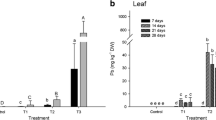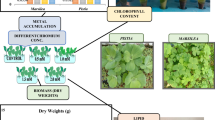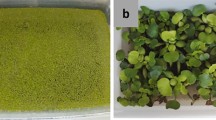Abstract
The present study reports the capacity of the aquatic macrophyte Lemna minor to remediate combinations of Cu(II), Pb(II) and Cr(III) from a simulated natural environment. The effect of these metal mixtures on the growth of L. minor was also investigated using growth rate and biomass inhibition calculations. L. minor was successful in removing Cr and Pb from the water, and it remained an effective remediation agent when both metals were present in the environment. However, a relatively low absorption capacity was observed for Cu, increasing concentrations of which were associated with significant decreases in growth rate. No statistically significant difference was found between the 24 h and 7 days absorption rates of Cu, Pb and Cr, suggesting that, at the concentrations tested, equilibrium occurs within 24 h of metal exposure.
Similar content being viewed by others
Explore related subjects
Discover the latest articles, news and stories from top researchers in related subjects.Avoid common mistakes on your manuscript.
Metals are some of the most common pollutants in the ecosystem, and their tendency to readily accumulate in food chains renders them an important health hazard. Consequently, a wide variety of physical, chemical and biological methods have been developed to remove metals from the environment, and the use of live or processed plants for the sorption of metals from aquatic ecosystems has received considerable attention in recent decades. However, most phytoremediation experiments focus separately on the removal of each individual metal, as it is difficult to account for interrelations between the accumulations of different elements in plant tissue. Such an experimental setup may not necessarily reflect a metal-contaminated natural environment, where many metals are often present in high concentrations (Horvat et al. 2007). As such, further research is necessary to fully elucidate how multiple metals affect the uptake and metabolization of each other.
Lemna minor (duckweed) is an aquatic macrophyte commonly utilized in toxicology research, and it has been suggested as a potential phytoremediation agent due to its high reproductive rate, ease of culturing and capacity to absorb a variety of metals (Elmacı et al. 2009). However, the effects of multiple metal exposure on the biosorption and metal retention rates of L. minor are largely unknown. As such, we aim to elucidate the interplay between the uptake mechanisms of different metals in this aquatic plant by observing the biosorption of Cr, Pb, Cu mixtures in different concentrations by L. minor in a simulated natural environment. We also describe the toxicity of those metals, alone or in conjunction with each other, to estimate how the presence of multiple metals may alter the growth of L. minor in multi-element contaminated environments.
Materials and Methods
All studies were carried out in a semi-controlled environment, if applicable. L. minor culture conditions were arranged per OECD procedure (OECD 2002). L. minor specimens were collected from a local lake, identified in the Ankara University Department of Biology, and maintained as stock cultures in greenhouse pools. Specimens collected from the pools were acclimated to test conditions in 50 L glass aquaria for 8 weeks, transferred to culture containers via aseptic tools and further acclimated for a period of 7 days. In order to simulate the natural environment of L. minor, tests were carried out under natural lighting and temperature changes, and water from the culture pools of the specimens were used in place of growth media. Temperatures in the semi-controlled environment varied between 5 and 20°C, and specimens experienced approximately 10 h day:14 h night cycles. Experiments were carried out with seven different mixtures of Cu, Pb and Cr, and a metal-free control group maintained under same conditions as the test medium. Water parameters including pH, dissolved oxygen (DO), electrical conductivity (EC) and temperature were measured and visual changes in duckweed fronds were observed throughout the experimental period. Initial and final water parameters of the test containers are given in Table 1.
Equipment made of glass and chemically inert materials were used throughout the study. All test containers were wide enough to enable fronds from different colonies to develop without overlapping each other. All specimens were grown in 200 mL pool water in chemically inert 500 mL containers. Tops of the test containers were covered in order to prevent water evaporation and accidental contamination (OECD 2002). Glass covers were used in order to enable sunlight transmission. All tests were carried out in triplicate.
As the simulated natural conditions utilized in the present study are likely to alter the metal tolerance of L. minor, a preliminary study was carried out to determine the optimal metal doses to be used in the bioremediation test. For the conditions of this study, EC50 values of Cr, Cu and Pb were determined to be 10.946, 4.359, 0.875 mg/L, respectively. Initial spiking concentrations for biosorption experiments were chosen to be slightly lower than the EC50 values; and were 10.4, 3 and 0.2 mg/L for Cr, Cu and Pb, respectively. Those values were unlikely to cause significant mortality, but they remain above the maximum acceptable concentration for Turkish inland waters (Anonymous 2004). In addition, it must be noted that our EC50 values were generally higher than those reported in the literature (Blinova 2004; Drost et al. 2007), suggesting that our culture conditions may lower L. minor mortality or that our plant stock might be more tolerant to heavy metals due to its relatively recent acquisition from a lake near an industrial city.
Only specimens with two or three fronds were utilized for measurement, and a total of 21 fronds per container were selected for analysis at the end of the 7-day experimental period (OECD 2002). Water samples from all test and control groups were taken at experiment initiation (i.e. the 0th day) and the 1st and 7th day of the test. At experiment initiation and closure, 10 mL aliquots were taken from the water surface, filtered through Whatman filter papers (pore size = 45 μm), acidified with 65 % nitric acid to a final concentration of 2 % and analyzed by an Agilent 7500a series ICP/MS. For quality control, four internal standards (9Be, 45Sc, 103Rh, 208Bi) were run together with the samples. Five different reference materials, covering all elements in the study, were utilized to eliminate the possibility of element loss during the preparation procedure. Three standards were used for each element to cover the analytical working range of the instrument. Ultrapure water was used to prepare calibration standards and blanks. Three runs were performed for each sample.
The percentage metal efficiency was calculated following Tanhan et al. (2007).
Where C0 and C1 are initial and final concentrations of the metal in medium (μg/L).The growth rate of L. minor was calculated with the following formula, following OECD standards (2002).
μi−j average specific growth rate from moment time i to j, Nj number of fronds observed in the test or control vessel at time j, Ni number of fronds observed in the test or control vessel at time i, ti moment time for the start of the period, tj moment time for the end of the period.
Percentile biomass inhibition rates of L.minor were calculated with the following formula, following OECD standards (2002).
% Ib percent reduction in biomass, bc ln(final biomass) minus ln(starting biomass) for the control group, bT ln(final biomass) minus ln(starting biomass) in the treatment group.
Mann–Whitney U test was used to determine the differences between the removal rates of the metals at 1st and 7th days. SPSS 17.0 (IBM, Portsmouth, UK) was utilized for all statistical analyses.
Results and Discussion
Due to their structural similarity to essential elements, non-essential metals can enter plant cells via non-selective ion channels and damage cellular components either directly (by competing with native anions and blocking enzyme function) or indirectly (by producing reactive oxygen species). Both effects are highly damaging to chloroplasts, with the former allowing metal cations to directly destroy the structure and function of chloroplast membranes and the latter resulting in various forms of damage in all organelles, including the peroxidation of chloroplast membranes (Romero-Puertas et al. 2004). In addition, metal ions inhibit the uptake and transportation of essential elements such as Mn, Zn and Fe (Hou et al. 2007).
While essential for plant metabolism, Cu is known to adversely affect L. minor in concentrations as low as 0.05 μmol/L (Li and Xiong 2004). EC50 values for L. minor have previously been determined by Wang (1986) (1.1 mg/L for 48 h of exposure), Khellaf and Zerdaoui (2009) (0.45 mg/L for 4 days of exposure) and Drost et al. (2007) (9.7 μM for 7 days of exposure). Our observations indicate that, at the concentrations tested, Cu remediation by L. minor reaches equilibrium within the first 24 h of exposure. Mixture 7 samples displayed the highest Cu removal within the first 24 h, while the highest total Cu removal at 7 days was observed in Mixture 4 (which was expected given the increased Cu concentration in this sample). While slight differences between day 1 and day 7 concentrations may suggest that some additional Cu removal (or release) might occur after the initial 24 h period, such differences are not statistically significant (Table 2). Cu removal by L. minor has been reported by Elmacı et al. (2009) (69.12 % in 24 h), Wahaab et al. (1995) (35 %–40 % in 10 days) and Miretzky et al. (2004) (90.41 % in 15 days).
Pb is a non-essential metal and displays toxic effects even in trace amounts (Ucuncu et al. 2012). EC50 values of 8 and 0.085 mg/L were reported for L. minor exposed to Pb over 2 and 7 days, respectively (Blinova 2004; Wang 1986). As with Cu, similar values were obtained for 24th hour and 7th day Pb removal rates, suggesting that Pb biosorption is mostly completed within the first 24 h of exposure (Table 2). 24 h percentile removal rates of Pb by L. minor have been reported as 76 % (Axtell et al. 2003) and 94.19 % (Elmacı et al. 2009) within 24 h, while a 98.55 % removal rate was reported for a 15 days exposure study (Miretzky et al. 2004).
Cr, a non-essential element for plants, is highly detrimental to plant growth and development (Mishra and Tripathi 2008). An EC50 value of 5.2 mg/L was previously reported in L. minor for 7 days of Cr exposure (Blinova 2004). Like the previous elements, Cr removal was observed to occur mainly within the first 24 h (Table 2).
This result is unusual, as Cr mobility is very low in many plants due to the absence of an efficient Cr transport mechanism from the roots to the shoots, as well as the presence various barriers to Cr transport in general (Miretzky et al. 2004). As such, low Cr removal rates are observed in a number of plant species. High Cr removal rates in this study might indicate that the barriers for Cr transportation present in many plants are lacking in L. minor, or that the latter plant possesses a transport mechanism either specific to, or exploitable by, Cr cations. Cr sorption rates of L. minor were reported as 75 %–100 % (Wahaab et al. 1995) and 96.94 % for (Miretzky et al. 2004) for 10 and 15 days, respectively.
No statistical difference was found between removal rates at 1st and 7th day for any metal or mixture (Table 2). We thus infer that, at the concentrations tested, biosorptions of Cr, Cu and Pb are largely completed within the first 24 h. Rahmani and Sternberrg (1999) suggested that, during Pb uptake by L. minor, the saturation of a finite number of binding sites on cell surfaces occurs after the first week of exposure, and that Pb transport from the cell surface into the inner cell mass may be the limiting step for subsequent removal. In this study, no significant difference could be found for the 24th hour and 7th day absorption rates, suggesting that binding site saturation could be completed within the first 24 h for Pb. However, it must be noted that our culture conditions, concentration ranges and frond numbers were different from those of Rahmani and Sternberrg (1999), which might have caused the discrepancy between observed saturation rates.
Growth rate and biomass inhibition calculations were carried out in order to evaluate the effect of the metals tested on L. minor development (Table 3). High biomass inhibition rates were observed in all Cu-incorporating mixtures (i.e. 82.89 % for Mixtures 4, 6 and 7; 68.42 % for Mixtures 1 and 5), suggesting that high concentrations of Cu have a strong detrimental effect on L. minor growth. Growth rate measurements are also in agreement with percentile inhibition rate results, yielding the lowest frond/day growth rate (0.03) for Mixtures 4, 6 and 7 while the highest result (0.1 fronds/day) was obtained in the Cr + Pb Mixture. As such, it is readily apparent that Cu greatly hinders L. minor growth even in sub-lethal doses, and high (i.e. above 10 mg/L) Cu concentrations may cause the disintegration of antioxidant system in this plant (Hou et al. 2007). In addition, L. minor had a relatively low Cu biosorption rate, and should be considered unsuitable for use in the remediation of heavily Cu-contaminated areas. Despite the essential role of Cu in plants, we found that higher doses of this element can hamper L. minor growth to a much greater extent than Cr and Pb, which might be caused by Cu-mediated oxidative damage. Similar results have been observed in the literature for other plants (Saygıdeğer and Doğan 2004).
Conclusion
The present study demonstrates that L. minor is effective in the remediation of Cr and Pb, even when exposed to both contaminants. As such, the use of duckweed for phytoremediation can be feasible for freshwater ecosystems contaminated primarily with those two metals. However, L. minor has displayed a relatively low absorption capacity for Cu, and the presence of this metal negatively affected frond growth. As such, L. minor is unsuitable for metal removal in Cu-contaminated environments under the conditions utilized in this study, and other remediation agents should be considered instead. In addition, we demonstrate that the bioremediation of Cr, Cu and Pb is largely completed within the first 24 h and that there is no statistically significant difference between the amounts absorbed at the 24th hour and on the 7th day. As such, we conclude that L. minor is capable of relatively rapid and effective bioremediation in the concentration ranges tested, especially for Pb and Cr.
While much work has been performed to evaluate the metal-removing capabilities of a wide spectrum of organisms, bioremediation of metals remains a developing topic, and further research is necessary to identify key remediative agents for each freshwater, marine and terrestrial biome. The conclusions reached with this study may be of particular value to future bioremediation studies in natural freshwater ecosystems, where multiple metals are often present in varying concentrations.
References
Anonymous (2004) Ministry of environment and forestry, water pollution control regulation. 31 December, 25687
Axtell NR, Sternberg SPK, Claussen K (2003) Lead and nickel removal using Microspora and Lemna minor. Bioresour Technol 89(1):41–48
Blinova I (2004) Use of freshwater algae and duckweeds for phytotoxicity testing. Special issue: 11th international symposium on toxicity assessment. Environ Toxicol 19(4):425–428
Drost W, Matzke M, Backhaus T (2007) Heavy metal toxicity to Lemna minor: studies on the time dependence of growth inhibition and the recovery after. Chemosphere 67(1):36–43
Elmacı A, Özengin N, Yonar T (2009) Removal of chromium (III), copper (II), lead (II) and zinc (II) using Lemna minor L. Fresen Environ Bull 18(5):538–542
Horvat T, Vidakovic-Cifrek Z, Orescanin V, Tkalec M, Pevalek-Kozlina B (2007) Toxicity assessment of heavy metal mixtures by Lemna minor L. Sci Total Environ 384(1–3):229–238
Hou W, Chen X, Song G, Wang Q, Chang CC (2007) Effects of copper and cadmium on heavy metal polluted waterbody restoration by duckweed (Lemna minor). Plant Physiol Biochem 45:62–69
Khellaf N, Zerdaoui M (2009) Growth response of the duckweed Lemna minor to heavy metal pollution. Iran J Environ Health Sci Eng 6(3):161–166
Li TY, Xiong ZT (2004) A novel response of wild type duckweed (Lemna paucicostata Hegelm.) to heavy metals. Environ Toxicol 19(2):95–102
Miretzky P, Saralegui A, Cirelli AF (2004) Aquatic macrophytes potential for the simultaneous removal of heavy metals (Buenos Aires, Argentina). Chemosphere 57:997–1005
Mishra VK, Tripathi BD (2008) Concurrent removal and accumulation of heavy metals by the three aquatic macrophytes. Bioresour Technol 99(15):7091–7097
OECD Organization for Economic Co-operation and Development (2002) Guidelines for the testing of chemicals Lemna sp. Growth inhibition test draft guideline OECD 221
Rahmani GNH, Sternberrg SPK (1999) Bioremoval of lead from water using Lemna minor. Bioresour Technol 70(3):225–230
Romero-Puertas MC, Rodriguez-Serrano M, Corpas FJ, Gomez M, Del Rio LA, Sandalio LM (2004) Cadmium- induced subcellular accumulation of O2 and H2O2 in pea fronds. Plant Cell Environ 27:1122–1134
Saygıdeğer S, Doğan M (2004) Lead and cadmium accumulation and toxicity in the presence of EDTA in Lemna minor L. and Ceratophyllum demersum L. Bull Environ Contam Toxicol 73(1):182–189
Tanhan P, Kruatrachue M, Pokethitiyook P, Chaiyarat R (2007) Uptake and accumulation of cadmium, lead and zinc by Siam weed [Chromolaena odorata (L.) King and Robinson]. Chemosphere 68:323–329
Ucuncu E, Tunca E, Fikirdesici S, Altindag A (2012) Decrease and increase profile of Cu, Cr and Pb during stable phase of removal by duckweed (Lemna minor L.). Int J Phytoremediation 15(4):376–384
Wahaab RA, Lubberding HJ, Alaerts GJ (1995) Copper and chromium(III) uptake by duckweed. Water Sci Technol 32(11):105–110
Wang W (1986) Toxicity tests of aquatic pollutants by using common duckweed. Environ Pollut B 11(1):1–14
Acknowledgments
This research project (No. 111Y202) was supported by TÜBİTAK (Scientific and Technological Research Council of Turkey). The authors are grateful to Fatma Kılıç, Gültekin Yılmaz and Dr. Fatih Duman for their valuable assistance.
Author information
Authors and Affiliations
Corresponding author
Rights and permissions
About this article
Cite this article
Üçüncü, E., Tunca, E., Fikirdeşici, Ş. et al. Phytoremediation of Cu, Cr and Pb Mixtures by Lemna minor . Bull Environ Contam Toxicol 91, 600–604 (2013). https://doi.org/10.1007/s00128-013-1107-3
Received:
Accepted:
Published:
Issue Date:
DOI: https://doi.org/10.1007/s00128-013-1107-3




